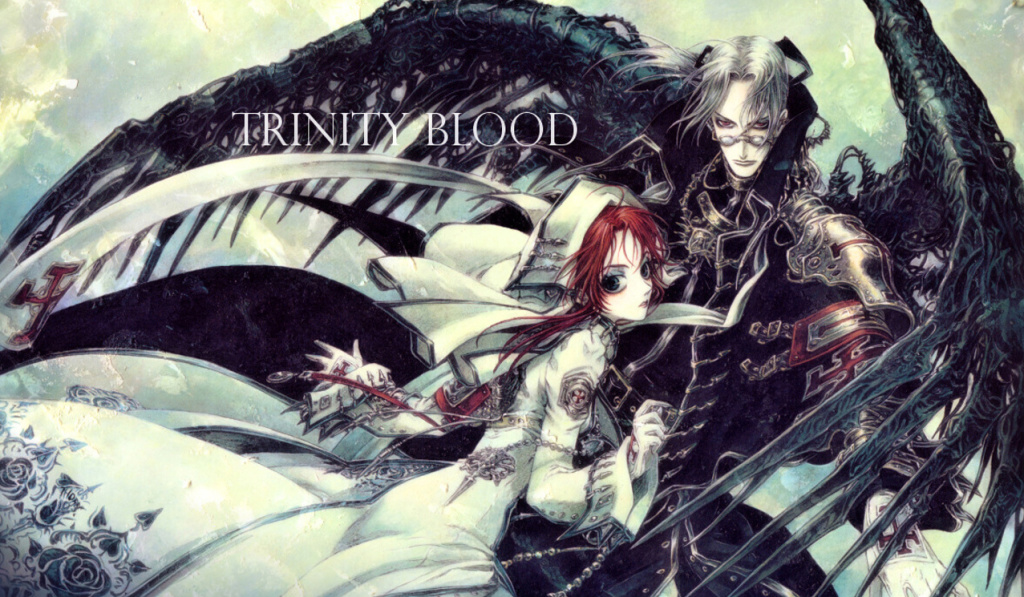(Warning: The following contains minor spoilers!)
Are you a devoted Catholic Christian who just happens to be looking for an excuse to kick back and enjoy some cartoons imported from the Land of the Rising Sun? Well, you’ve come to the right place!
As anyone who has come across the amusing Facebook group Catholic Anime knows, there are quite a few Catholic fans of Japanese animation busily perusing the web and making goofy memes featuring their favorite characters. What these fans may not know is that there are actually some anime series out there that consciously make use of Catholic themes and symbolism – some overtly, some subtly.
(Note: I argue that Catholic themes feature strongly in the series listed below. I do not argue that they are necessarily appropriate for all ages. If you’re looking for something family-friendly in the anime genre, I highly recommend the films of Studio Ghibli.)
Without further ado, let’s explore!
4) Samurai Champloo

This semi-historical series chronicles the adventures of three companions – Jin, Mugen, and Fuu – traveling across Tokugawa-era Japan in search of the mysterious Sunflower Samurai. Along the way, they encounter obstacles ranging from corrupt government officials, to Dutch fans of Geisha, and even a family of vengeful pirates. The series features an amusingly anachronistic soundtrack composed of hip-hop tunes along with its historical setting in the late Edo Period (mid-1800s). It also includes action sequences featuring “martial arts” reminiscent of hip-hop dance culture.
So what does any of this have to do with Catholicism? Well, in this case it has less to do with the story’s themes than with a little-known chapter of Japanese history.
The series finale – the three-part episode Evanescent Encounter – features a subplot concerning a group of persecuted Japanese Christians, one of whom is of great significance to a main character. Not much is said in dialogue about this persecution, but what we glimpse via flashbacks effectively hints at the martyrdom that this group, like their real-life historical counterparts, suffered at the hands of their Tokugawa persecutors. An earlier episode also addresses the reality of persecuted Christians, and even includes a historically correct scene in which Japanese villagers are lined up and ordered – under threat of the sword – to stomp on an image of Christ to prove their loyalty to Japan.
The martyrs of Japan are a rather neglected group in the history of Christianity. It’s satisfying, then, to see them featured in a highly rated series produced in the very country in which they were subjected to such awful oppression.
3) Cowboy Bebop

Widely regarded as one of the greatest anime series of all time, Cowboy Bebop takes place in a distant future in which humanity has colonized the vast regions of outer space. It follows a motley crew of bounty hunters – Spike Spiegel, the main protagonist and a former syndicate member; Jet, Spike’s partner and an ex-cop; Faye, a female bounty hunter with a mysterious past (duh!); and Edward, a young hacker – who live together as family on their spaceship, the Bebop, working together to bring down the most dangerous criminals in the solar system… for a price.
The show’s main antagonist is the aptly named Vicious, a sword-wielding figure from Spike’s past, and a purely diabolical individual. Through Vicious, overtly Catholic themes of good and evil become the series’ ultimate focus: When we meet Vicious in the episode Ballad of Fallen Angels (Get that?), it is to the sound of Ave Maria being sung in the background; Spike’s first confrontation with Vicious takes place in an abandoned – and ornate – church; Many of Vicious’s spoken lines evoke theology (“When angels are forced out of Heaven, they become devils.”), and Vicious is repeatedly described as a “serpent” (in case the symbolism wasn’t already clear enough).
The confrontation between Spike and Vicious, framed in the context of an eternal battle between virtue and the diabolic, and masterfully directed by Shinichiro Watanabe (who would go on to direct Samurai Champloo) in a style reminiscent of John Woo, helps make Cowboy Bebop by far the most popular series on this list, and arguably the best.
2) Death Note

As the title should imply, Death Note is by far the darkest entry on this list, and it also happens to be one of the more popular anime series in recent years. It follows a brilliant but disillusioned young man named Light Yagami who one day finds a notebook with a series of bizarre instructions printed inside. The first instruction states simply, “The human being whose name is written in this notebook shall die.” With some assistance from a Shinigami (or “god of death”) named Ryuk, Light embarks on a hubristic mission to reshape the world in his own image, with the ultimate goal of enthroning himself as God – and passing judgment on anyone who gets in his way.
While it is unclear whether it is the writer’s intention, Light Yagami works perfectly as a human metaphor for the Devil. Remember, for example, that “Lucifer” translates as “Light bearer” and that Satan’s sin was that he wished – like Light – to become God. Light’s gradual development as he strives for this unholy goal provide a vivid illustration of the Catholic understanding of evil. The series is also full of subtle nods to Christianity in the forms of symbolism and music. Just seconds into the first episode, we are treated to a traditional Kyrie, which is then featured in various forms throughout the series (usually accompanying the show’s supernatural story elements). Crosses, crucifixes, and a burning church are just a few more visual hints of the series’ central message.
Spoilers for Death Note should be avoided at all cost, but suffice it to say that the story as a whole can be taken as a stern warning: “Judge not, lest you be judged.”
1) Trinity Blood

Your parents may remember a show from their youth called Father Dowling Mysteries, in which a Roman Catholic priest investigates crimes and is often accompanied by a nun as his sidekick. Well, add vampires and Japanese animation, and you get Trinity Blood.
Is Trinity Blood the best series on this list? Nope, but it is far and away the most Catholic. The main character is Abel Nightroad, a Catholic priest and a “Crusnik,” a vampire who feeds on other vampires. His companion is the young nun Esther Blanchet, who accompanies him on peacekeeping missions that (obviously) usually end up turning into action-packed battles. Pretty much every major male character is also a priest, and many of the female characters are nuns (or, weirdly, a Cardinal – but we’ll let that slide). Even the Pope (the Pope!) is a recurring character with his own subplot, for Pete’s sake (pun intended)!
Trinity Blood is openly respectful of the Catholic Church as a peacekeeper and as a force for good in the world (although I’ve been informed that, as of the time of this writing, Pope Francis has yet to inaugurate the Vatican’s anti-vampire branch). Fr. Nightroad’s vampirism is framed as an effective metaphor for the fallen nature of Man. He struggles constantly and sometimes succumbs to his wicked urges, but this is always followed by the possibility of repentance and a renewed commitment to battle the forces of darkness.
*As a side note, whoever animated this series has a serious crush on classical European (read: Catholic) art and architecture.
If Japanese anime were more popular, American Atheists might have sued to get Trinity Blood removed from Netflix by now (or at least put up an annoying billboard complaining about it).
Conclusion
Ok, so Japanese anime isn’t for everyone, and if you’re not a fan, nothing on this list will convert you (pun intended, again).
But at the very least I hope that you find it gratifying to know that even in Japan, where the number of baptized Catholics is dismally low, a small portion of Catholicism’s message can still be heard – if only through imperfect channels.


